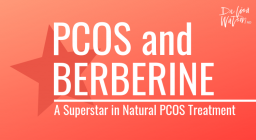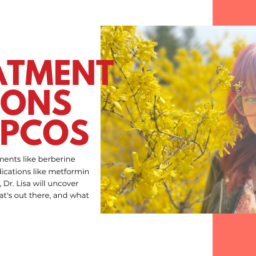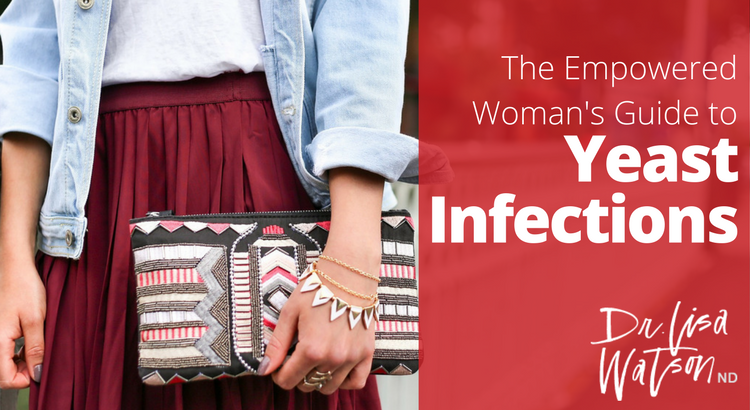
If you have been reading my blog (yay you!), then you know my core mission is to empower women to demand more from their health. No more accepting mediocrity in our bodies and our wellness. You CAN feel better.
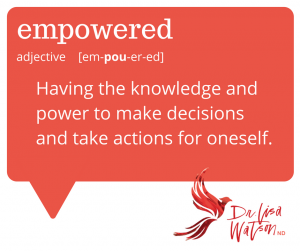 And the one condition I am constantly amazed that women are living with, without successful treatment, are yeast infections.
And the one condition I am constantly amazed that women are living with, without successful treatment, are yeast infections.
Ladies! You don’t have to live like this. If this is your first yeast infection, congratulations. You are going to learn how to deal with this right, the first time. If this is your third, or fourth, or fortieth – I am so glad you are here. Because we are going to get into some serious action-oriented information that you need to learn.
So let’s do this.
What is a Yeast Infection
A yeast infection is an overgrowth of yeast, usually Candida albicans that causes irritation to the vagina and vulva. Also known as VVC (vulvovaginal candidiasis), candida is most often self diagnosed and treated with over the counter creams and capsules.
While most women think of a yeast infection when they experience a thick, whitish discharge, only 20% of cases actually have this symptom. The more common symptoms of a yeast infection are itching, swelling of the vulva and pain on urination (especially after peeing).
What is NOT a Yeast Infection
While most women self diagnose yeast infections, there are a number of imbalances that can occur in the lady garden that look like yeast infections, but aren’t.
Vaginitis – an infection of the vagina with inflammation. A yeast infection is a type of vaginitis, but this can also be caused by other infections, like trichomoniasis.
Vaginosis – the overgrowth of vaginal bacteria without inflammation. Most commonly caused by Gardnerella, BV (bacterial vaginosis) is incredibly common – even more so than yeast infections. But that is the subject of another article (coming very soon!)
Other conditions that are not yeast infections – contact irritation, allergic reactions, atrophic vaginitis, menopausal dryness, cytolytic vaginosis (Write this article too) and sexually transmitted illnesses like Chlamydia and gonorrhea.
What Your Doctor Isn’t Telling You About Yeast Infections
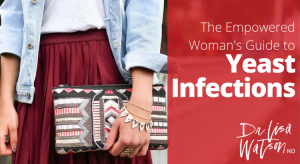 Yeast infections don’t need to be difficult to treat. They don’t need to be recurrent. The problem is that doctors aren’t offering complete solutions to women with yeast infections.
Yeast infections don’t need to be difficult to treat. They don’t need to be recurrent. The problem is that doctors aren’t offering complete solutions to women with yeast infections.
When you talk to your MD about yeast infections, most often you are told to take an over-the-counter antifungal medication that will kill the yeast. Sounds ok right? Well, no… not right.
Killing the yeast is important, there is no doubt about that. But killing the yeast does nothing to change the environment that the yeast was growing in. And since yeast is everywhere (yeast spores are airborne – you are going to be exposed to them both in your environment and from your digestive tract every day of your life) if you don’t change the environment, you’ll like just get another yeast infection.
The Empowered Approach to Yeast Infection Treatment
I’m going to present you with my empowered approach to fighting yeast infections. It takes a bit longer than the typical over-the-counter remedies – but it works a lot better. So if you’re ready to conquer candida, for once and for all, read on.
-
Pay attention to pH
The healthy normal pH of the vaginal tract is around a 3.8-4.5. When you have candida (or BV), that pH can be increased above a 4.5. This occurs due to a change in the healthy bacteria, Lactobacillus, that should be the main bacteria in the vagina.
If you want to resolve your yeast infection, you need to pay attention to pH. If you optimize the normal, acidic pH of the vaginal tract, the yeast and nasty bacteria can’t thrive and the lactobacillus species can.
The best way to do this is with boric acid suppositories. Boric acid sounds scary – but remember, the vaginal tract is meant to be acidic. Using boric acid will restore the optimal pH and support the healthy bacteria populations. Made by a local compounding pharmacist, boric acid is simple to use and very effective.
-
Eradicate the yeast
Ok. Yes, we do need to eradicate the yeast. But as I mentioned above, it can’t be the ONLY step in a successful yeast treatment. Most often I recommend using nature’s favourite antifungal – garlic – often combined with some caprylic acid (from coconut). Taken orally, or sometimes vaginally, these two are a powerhouse of antifungal activity.
But we don’t stop there. We also look at your diet. Yeast thrives in a high sugar environment, so I suggest avoiding all sugar (including dairy and bread products), alcohol and some fruits for at least a month while treating your yeast infection.
-
Restore beneficial bacteria
 Who hasn’t heard of the amazing benefits of probiotics? Those 300 trillion lovely little bugs that live in and on our body are a huge part of what makes us healthy (or not.)
Who hasn’t heard of the amazing benefits of probiotics? Those 300 trillion lovely little bugs that live in and on our body are a huge part of what makes us healthy (or not.)
In our lady garden, our boss bacteria is Lactobacillus. And imbalances in healthy levels of Lactobacillus are associated with BV and yeast infections.
The main source of bacteria for the vagina is from the “proximity exposure” to the exit of our digestive tract. So taking probiotics by mouth can be really effective for supporting healthy bacteria levels. Using vaginal probiotics is also highly recommended for yeast treatments, especially when using boric acid.
-
Prevent recurrence
Eradicate yeast? Check.
Promote healthy pH? Check.
Lots of Lactobacillus? Check.
Now how do we stop this from happening again? Avoiding triggers that can lead to yeast infections – like a diet high in sugar, dairy and wheat, diabetes and unstable blood sugar, tight clothing and artificial fiber underwear (cotton ladies, cotton) is imperative. You can discuss with your ND whether you should embark on a longer “Candida Diet” – this isn’t necessary for everyone, but can make all the difference for some.
-
Don’t accept mediocrity from your lady garden
I’ve said it before – and I’ll say it once more – yeast infections are not normal. And you don’t have to live with them. Now that you know better, I hope you will want better for yourself. And go out there and do it. You have been empowered – and I’m cheering you on.
Want a personalized treatment plan to get over your yeast infections? Book in and let’s talk. I’m ready when you are.


